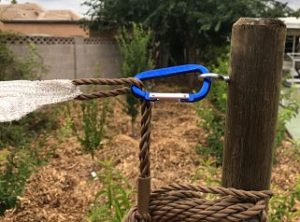Are You Cooking Your Fruit Trees?
by Farmer Ryan (Red Hat Ryan) Hossler
of 44 Paws Farm
With the summer heat fully entrenched in the Valley of the Sun, it’s important to take a moment and discover the details of the micro-climates within our gardens and orchards. Yes, there can be wide swings even within our own yards!
My new orange tree was struggling.
I had recently planted a Trovita orange tree, and was concerned as it was really struggling. I had followed all of Greg’s planting instructions – the deep wide water well and regular waterings, about 8” of woody mulch beneath it, the trunk was wrapped with tree wrap – and yet it was sickly yellow and shedding leaves fast. Suspecting the heat with the culprit, I grabbed my digital infrared thermometer (these have really come down in price lately, with decent models available for about $20). I was shocked to be getting readings of 168 degrees around my poor tree. This was on par with the temperature of the block wall fence nearby.
How can this be when the ‘official’ temperature in Phoenix at the time was only 101 degrees? Isn’t mulch supposed to keep the ground cooler?
How far down was the heat going?
I did some further investigating:
- Last year’s woody mulch, bleached by the sun (surface) dry – 168 degrees
- 1” down in last year’s mulch (moist)– 120 degrees (That was 48 degrees cooler)
- 8” down in last year’s mulch (damp) – 92 degrees (Actually 76 degrees cooler!)
What about other mediums?
- Freshly chipped mulch (surface) – 116 degrees
- Black (composted) mulch, dry – 180 degrees
- Black (composted) mulch, damp – 134 degrees
My take away from this is that while the mulch is keeping the actual soil temperatures down, the surface of that mulch, when dry, can reflect as much heat as concrete. My trees are on bubblers, and the bubblers are completely buried in mulch. So it’s not enough for me to just water under the surface of the mulch. I need to add some water to the surface as well. Not only will this help keep the mulch from warming up as quickly, it will help it break down faster as well.
I needed to cool that mulch.
My solution for my ailing Trovita was to add an additional layer of fresh (ie: wet) mulch underneath, as well as put up a shade cloth to give it some relief while it is getting established. I found a 13×7’ finished shade cloth at Costco for about $25. I purchased a couple wooden tree stakes, eye screws, and carabiners. I could have used the rope that came with the shade cloth, however, I opted to attach the cloth to the wooden tree stakes using the carabiners and eye screws so I could easily detach the cloth when a monsoon storm threatened. I didn’t want it to become a giant sail that could come loose and cause damage to my trees (I’ve had it happen with a neighbors shade cloth came loose and got caught on a mature apricot tree in my yard and broke off half the tree during a storm!). The carabiners give me quick release compared with trying to untie rope. All told, the entire project cost just under $40.

Now when I take the temperature under the shade cloth, I max out around 115. Additionally, until my trees grow and can self-shade, on days when the temperatures are forecast to soar, I’ll go out and moisten the top surface of the mulch.
About this author:

Ryan Hossler is a native of the Valley and has been growing for nearly four decades in our extreme climate. Some may recognize him from the Fruit Tree Nursery and many other Urban Farm programs. His current orchard and garden, 44 Paws Farm, is located in Central Phoenix, where he also manages a feral cat colony and their bountiful hybrids.
*Disclosure:
Some of the links in our podcast show notes and blog posts are affiliate links and if you go through them to make a purchase, we will earn a nominal commission at no cost to you. We offer links to items recommended by our podcast guests and guest writers as a service to our audience and these items are not selected because of the commission we receive from your purchases. We know the decision is yours, and whether you decide to buy something is completely up to you.








I’m just getting started. I bought a home about 2 months ago with two mature orange trees. I’ve created a basin for each of them and want to put some mulch around them to protect from the heat. One looks like it is suffering from heat stroke. Are the bags of red mulch from Lowes okay to use (on sale for 2.00 a bag this weekend) or should I stay away from wood chips with dye in them? Where is a good place to buy the mulch/wood chips if the home improvement center offerings aren’t good choices?
Dale
Dale – GREAT Question!!! YES Stay away from painted wood chips. We have no idea what is in the dye or paint. You want to use only chipped natural wood. We sell a natural wood product from Tanks Green Stuff at our General Store for $9 a 2 Cubic foot bag – AND if you buy 3 bags you get one free. Barry’s True Value Hardware on 12th Street and Northern also carry’s the product and the deal.
I live up in Chino valley. I got a deodara cedar tree (not from you). When I went to plant it I discovered the roots are all twisted around the trunk. See picture. Should I cut one or both when I plant it to prevent it from choking the truck as it grows since the trunks can get a foot in diameter or bigger. Should I plant it with those roots above ground since they are now.
Do you know if this tree roots can be invasive? I want to plant it about 50 foot from a water well.
Thanks
Teena